ACC00712: Inventory Management at Rio Tinto - AASB 101 & 102 Analysis
VerifiedAdded on 2023/06/11
|6
|1505
|332
Essay
AI Summary
This essay provides an analysis of Rio Tinto's inventory valuation and costing methods, focusing on compliance with AASB 101 and AASB 102 as mandated by the Australian Corporations Act 2001. It discusses the presentation of inventory in the Statement of Financial Position, the valuation of inventories at the lower of cost or net realizable value, and the computation of average costs. The essay also examines the perpetual inventory system used by Rio Tinto, highlighting its benefits for timely information and inventory control. Furthermore, it explores the weighted average costing method adopted by the company, explaining its advantages in accurately presenting inventory costs and cost of goods sold. The essay concludes by discussing the impacts of different inventory costing methods on financial statements and affirming Rio Tinto's compliance with relevant accounting standards, with reference to the company's 2017 annual report, where inventories were valued at US$ 3632m.
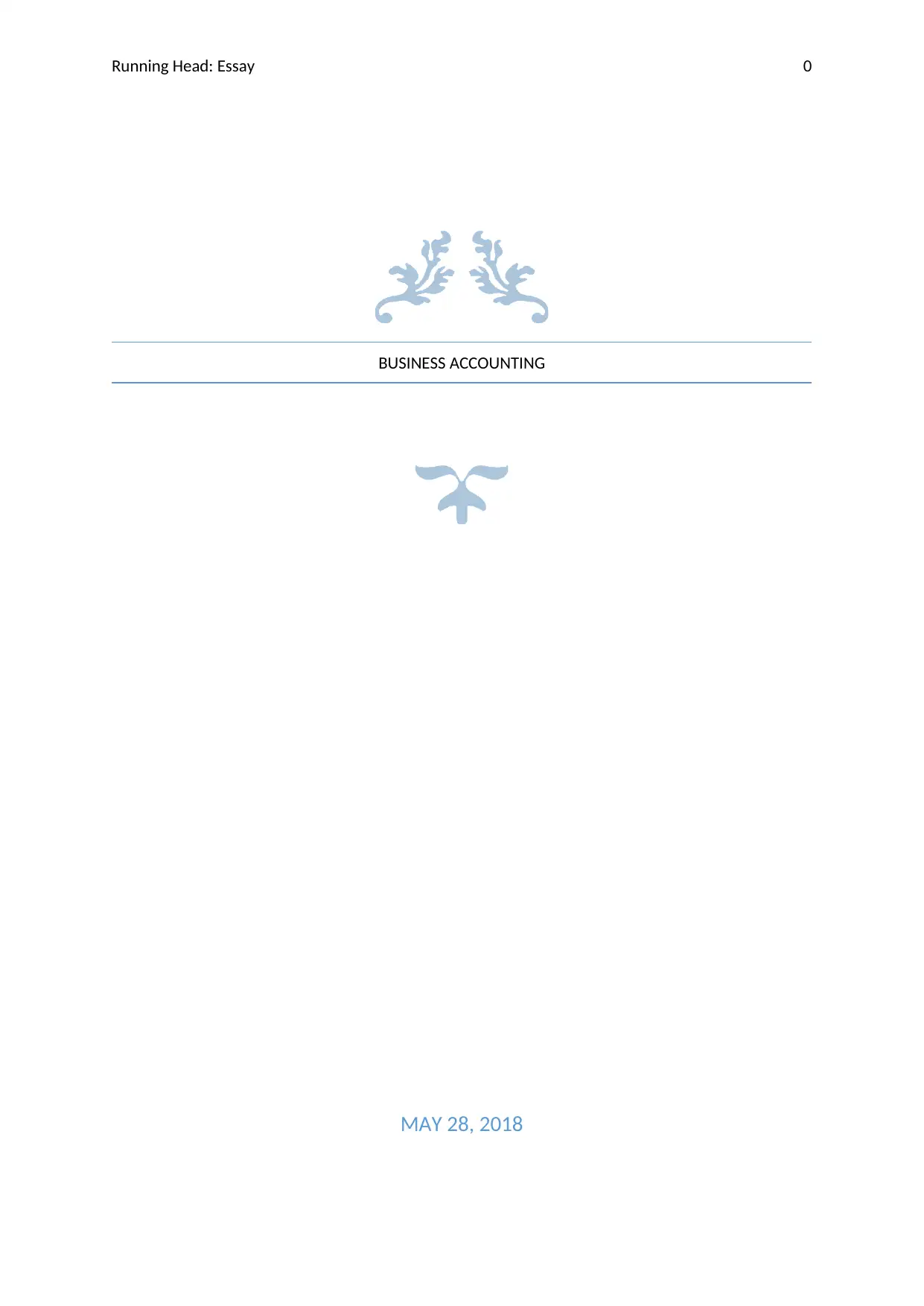
Running Head: Essay 0
BUSINESS ACCOUNTING
MAY 28, 2018
BUSINESS ACCOUNTING
MAY 28, 2018
Paraphrase This Document
Need a fresh take? Get an instant paraphrase of this document with our AI Paraphraser
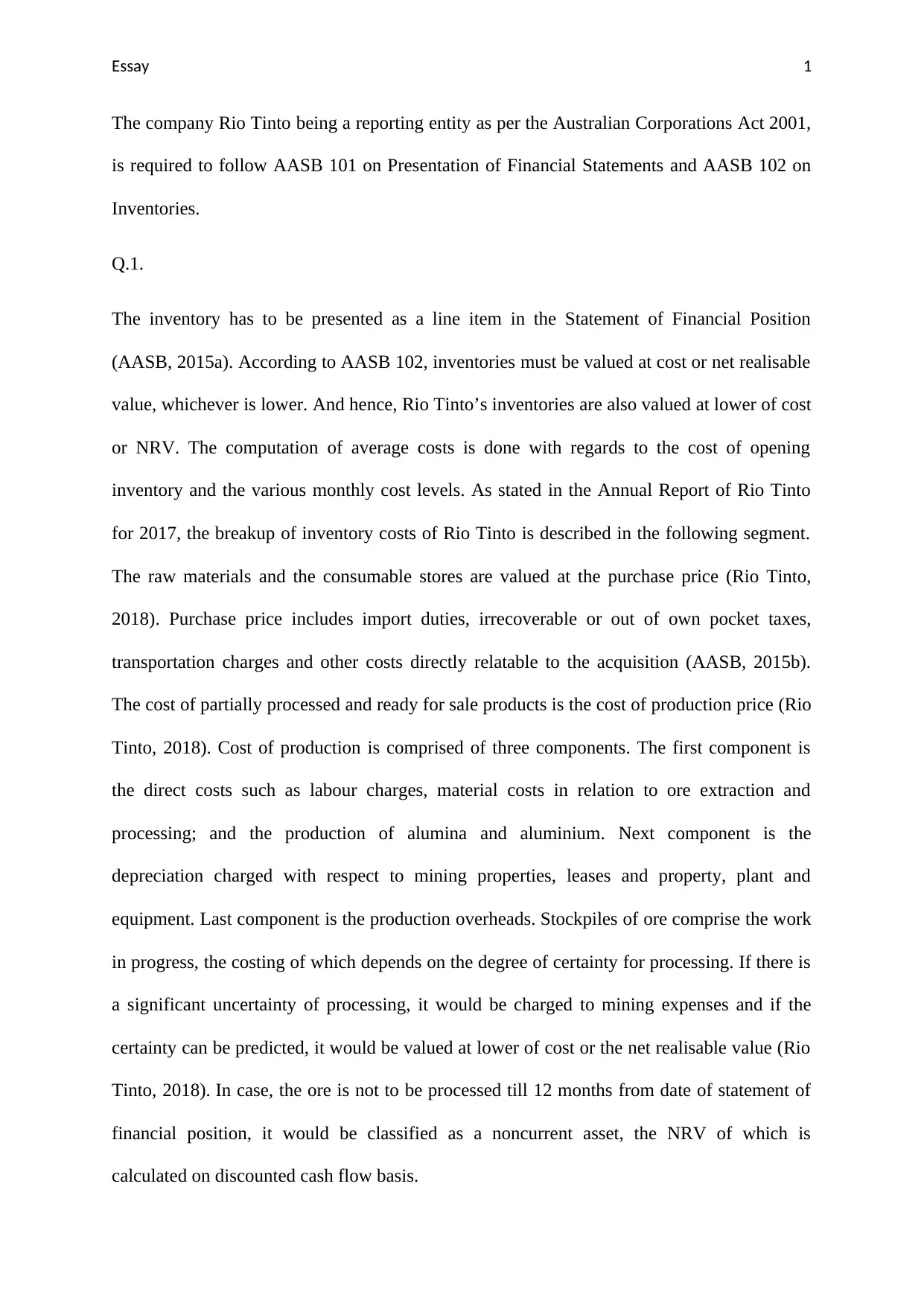
Essay 1
The company Rio Tinto being a reporting entity as per the Australian Corporations Act 2001,
is required to follow AASB 101 on Presentation of Financial Statements and AASB 102 on
Inventories.
Q.1.
The inventory has to be presented as a line item in the Statement of Financial Position
(AASB, 2015a). According to AASB 102, inventories must be valued at cost or net realisable
value, whichever is lower. And hence, Rio Tinto’s inventories are also valued at lower of cost
or NRV. The computation of average costs is done with regards to the cost of opening
inventory and the various monthly cost levels. As stated in the Annual Report of Rio Tinto
for 2017, the breakup of inventory costs of Rio Tinto is described in the following segment.
The raw materials and the consumable stores are valued at the purchase price (Rio Tinto,
2018). Purchase price includes import duties, irrecoverable or out of own pocket taxes,
transportation charges and other costs directly relatable to the acquisition (AASB, 2015b).
The cost of partially processed and ready for sale products is the cost of production price (Rio
Tinto, 2018). Cost of production is comprised of three components. The first component is
the direct costs such as labour charges, material costs in relation to ore extraction and
processing; and the production of alumina and aluminium. Next component is the
depreciation charged with respect to mining properties, leases and property, plant and
equipment. Last component is the production overheads. Stockpiles of ore comprise the work
in progress, the costing of which depends on the degree of certainty for processing. If there is
a significant uncertainty of processing, it would be charged to mining expenses and if the
certainty can be predicted, it would be valued at lower of cost or the net realisable value (Rio
Tinto, 2018). In case, the ore is not to be processed till 12 months from date of statement of
financial position, it would be classified as a noncurrent asset, the NRV of which is
calculated on discounted cash flow basis.
The company Rio Tinto being a reporting entity as per the Australian Corporations Act 2001,
is required to follow AASB 101 on Presentation of Financial Statements and AASB 102 on
Inventories.
Q.1.
The inventory has to be presented as a line item in the Statement of Financial Position
(AASB, 2015a). According to AASB 102, inventories must be valued at cost or net realisable
value, whichever is lower. And hence, Rio Tinto’s inventories are also valued at lower of cost
or NRV. The computation of average costs is done with regards to the cost of opening
inventory and the various monthly cost levels. As stated in the Annual Report of Rio Tinto
for 2017, the breakup of inventory costs of Rio Tinto is described in the following segment.
The raw materials and the consumable stores are valued at the purchase price (Rio Tinto,
2018). Purchase price includes import duties, irrecoverable or out of own pocket taxes,
transportation charges and other costs directly relatable to the acquisition (AASB, 2015b).
The cost of partially processed and ready for sale products is the cost of production price (Rio
Tinto, 2018). Cost of production is comprised of three components. The first component is
the direct costs such as labour charges, material costs in relation to ore extraction and
processing; and the production of alumina and aluminium. Next component is the
depreciation charged with respect to mining properties, leases and property, plant and
equipment. Last component is the production overheads. Stockpiles of ore comprise the work
in progress, the costing of which depends on the degree of certainty for processing. If there is
a significant uncertainty of processing, it would be charged to mining expenses and if the
certainty can be predicted, it would be valued at lower of cost or the net realisable value (Rio
Tinto, 2018). In case, the ore is not to be processed till 12 months from date of statement of
financial position, it would be classified as a noncurrent asset, the NRV of which is
calculated on discounted cash flow basis.
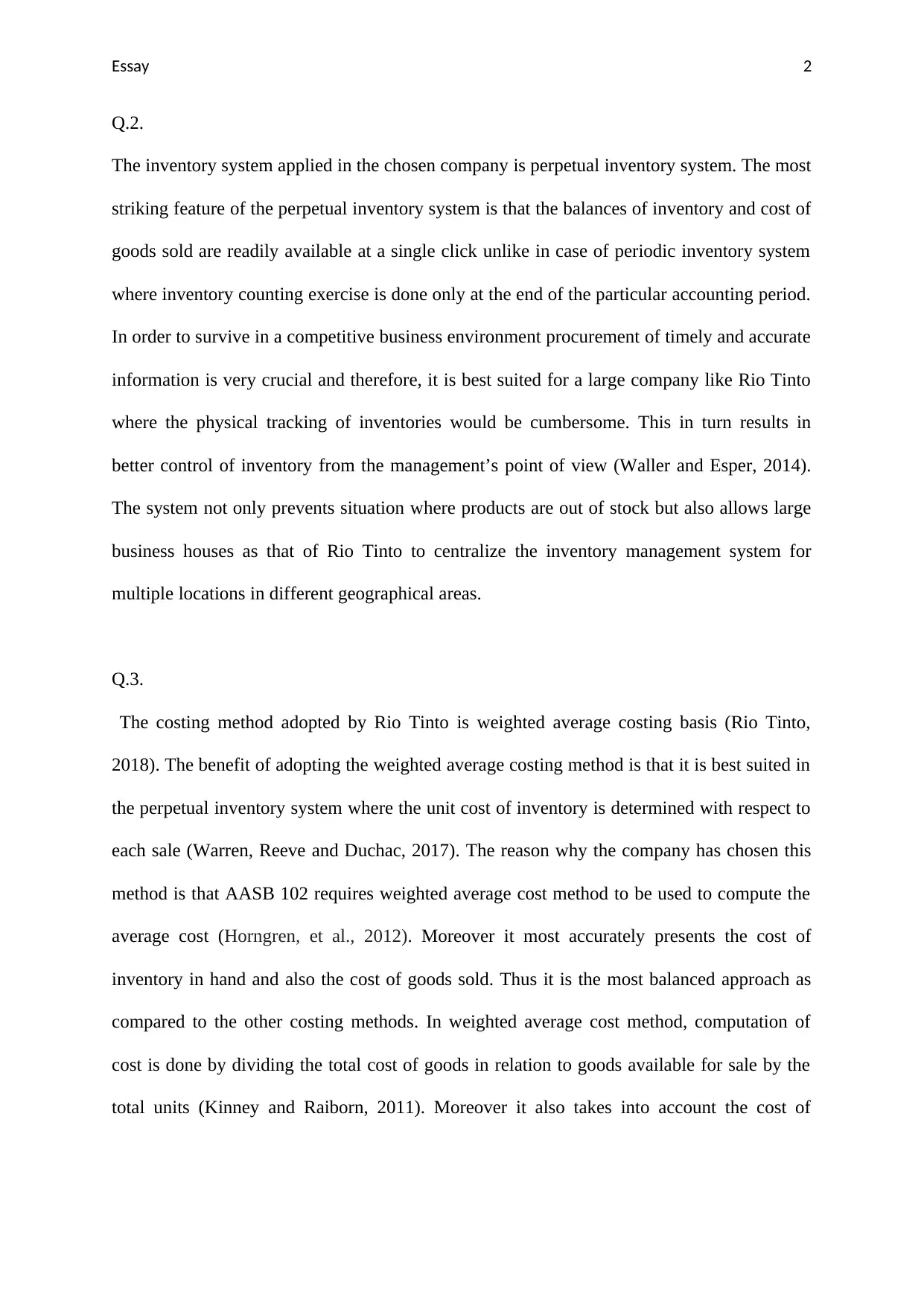
Essay 2
Q.2.
The inventory system applied in the chosen company is perpetual inventory system. The most
striking feature of the perpetual inventory system is that the balances of inventory and cost of
goods sold are readily available at a single click unlike in case of periodic inventory system
where inventory counting exercise is done only at the end of the particular accounting period.
In order to survive in a competitive business environment procurement of timely and accurate
information is very crucial and therefore, it is best suited for a large company like Rio Tinto
where the physical tracking of inventories would be cumbersome. This in turn results in
better control of inventory from the management’s point of view (Waller and Esper, 2014).
The system not only prevents situation where products are out of stock but also allows large
business houses as that of Rio Tinto to centralize the inventory management system for
multiple locations in different geographical areas.
Q.3.
The costing method adopted by Rio Tinto is weighted average costing basis (Rio Tinto,
2018). The benefit of adopting the weighted average costing method is that it is best suited in
the perpetual inventory system where the unit cost of inventory is determined with respect to
each sale (Warren, Reeve and Duchac, 2017). The reason why the company has chosen this
method is that AASB 102 requires weighted average cost method to be used to compute the
average cost (Horngren, et al., 2012). Moreover it most accurately presents the cost of
inventory in hand and also the cost of goods sold. Thus it is the most balanced approach as
compared to the other costing methods. In weighted average cost method, computation of
cost is done by dividing the total cost of goods in relation to goods available for sale by the
total units (Kinney and Raiborn, 2011). Moreover it also takes into account the cost of
Q.2.
The inventory system applied in the chosen company is perpetual inventory system. The most
striking feature of the perpetual inventory system is that the balances of inventory and cost of
goods sold are readily available at a single click unlike in case of periodic inventory system
where inventory counting exercise is done only at the end of the particular accounting period.
In order to survive in a competitive business environment procurement of timely and accurate
information is very crucial and therefore, it is best suited for a large company like Rio Tinto
where the physical tracking of inventories would be cumbersome. This in turn results in
better control of inventory from the management’s point of view (Waller and Esper, 2014).
The system not only prevents situation where products are out of stock but also allows large
business houses as that of Rio Tinto to centralize the inventory management system for
multiple locations in different geographical areas.
Q.3.
The costing method adopted by Rio Tinto is weighted average costing basis (Rio Tinto,
2018). The benefit of adopting the weighted average costing method is that it is best suited in
the perpetual inventory system where the unit cost of inventory is determined with respect to
each sale (Warren, Reeve and Duchac, 2017). The reason why the company has chosen this
method is that AASB 102 requires weighted average cost method to be used to compute the
average cost (Horngren, et al., 2012). Moreover it most accurately presents the cost of
inventory in hand and also the cost of goods sold. Thus it is the most balanced approach as
compared to the other costing methods. In weighted average cost method, computation of
cost is done by dividing the total cost of goods in relation to goods available for sale by the
total units (Kinney and Raiborn, 2011). Moreover it also takes into account the cost of
⊘ This is a preview!⊘
Do you want full access?
Subscribe today to unlock all pages.

Trusted by 1+ million students worldwide
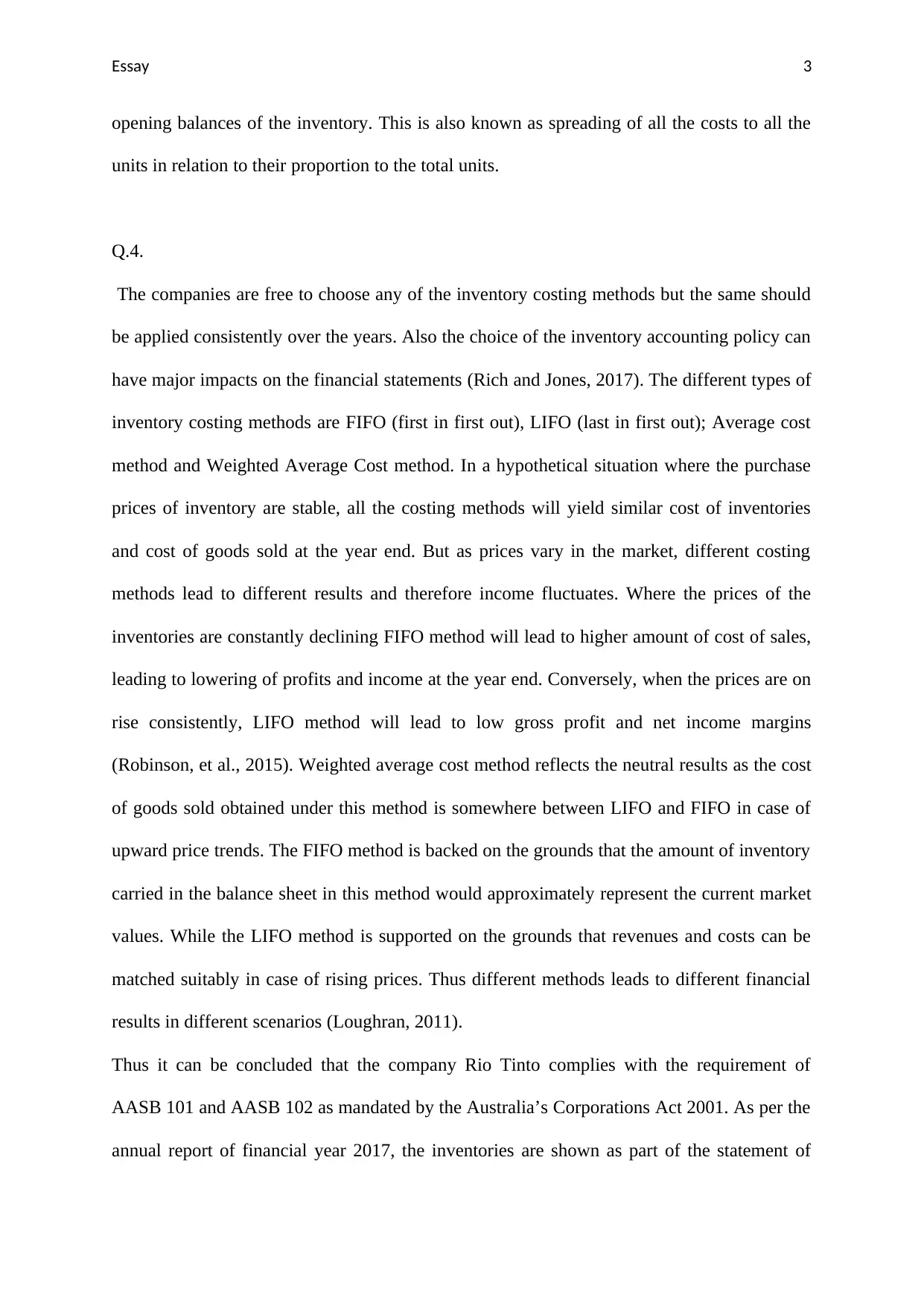
Essay 3
opening balances of the inventory. This is also known as spreading of all the costs to all the
units in relation to their proportion to the total units.
Q.4.
The companies are free to choose any of the inventory costing methods but the same should
be applied consistently over the years. Also the choice of the inventory accounting policy can
have major impacts on the financial statements (Rich and Jones, 2017). The different types of
inventory costing methods are FIFO (first in first out), LIFO (last in first out); Average cost
method and Weighted Average Cost method. In a hypothetical situation where the purchase
prices of inventory are stable, all the costing methods will yield similar cost of inventories
and cost of goods sold at the year end. But as prices vary in the market, different costing
methods lead to different results and therefore income fluctuates. Where the prices of the
inventories are constantly declining FIFO method will lead to higher amount of cost of sales,
leading to lowering of profits and income at the year end. Conversely, when the prices are on
rise consistently, LIFO method will lead to low gross profit and net income margins
(Robinson, et al., 2015). Weighted average cost method reflects the neutral results as the cost
of goods sold obtained under this method is somewhere between LIFO and FIFO in case of
upward price trends. The FIFO method is backed on the grounds that the amount of inventory
carried in the balance sheet in this method would approximately represent the current market
values. While the LIFO method is supported on the grounds that revenues and costs can be
matched suitably in case of rising prices. Thus different methods leads to different financial
results in different scenarios (Loughran, 2011).
Thus it can be concluded that the company Rio Tinto complies with the requirement of
AASB 101 and AASB 102 as mandated by the Australia’s Corporations Act 2001. As per the
annual report of financial year 2017, the inventories are shown as part of the statement of
opening balances of the inventory. This is also known as spreading of all the costs to all the
units in relation to their proportion to the total units.
Q.4.
The companies are free to choose any of the inventory costing methods but the same should
be applied consistently over the years. Also the choice of the inventory accounting policy can
have major impacts on the financial statements (Rich and Jones, 2017). The different types of
inventory costing methods are FIFO (first in first out), LIFO (last in first out); Average cost
method and Weighted Average Cost method. In a hypothetical situation where the purchase
prices of inventory are stable, all the costing methods will yield similar cost of inventories
and cost of goods sold at the year end. But as prices vary in the market, different costing
methods lead to different results and therefore income fluctuates. Where the prices of the
inventories are constantly declining FIFO method will lead to higher amount of cost of sales,
leading to lowering of profits and income at the year end. Conversely, when the prices are on
rise consistently, LIFO method will lead to low gross profit and net income margins
(Robinson, et al., 2015). Weighted average cost method reflects the neutral results as the cost
of goods sold obtained under this method is somewhere between LIFO and FIFO in case of
upward price trends. The FIFO method is backed on the grounds that the amount of inventory
carried in the balance sheet in this method would approximately represent the current market
values. While the LIFO method is supported on the grounds that revenues and costs can be
matched suitably in case of rising prices. Thus different methods leads to different financial
results in different scenarios (Loughran, 2011).
Thus it can be concluded that the company Rio Tinto complies with the requirement of
AASB 101 and AASB 102 as mandated by the Australia’s Corporations Act 2001. As per the
annual report of financial year 2017, the inventories are shown as part of the statement of
Paraphrase This Document
Need a fresh take? Get an instant paraphrase of this document with our AI Paraphraser
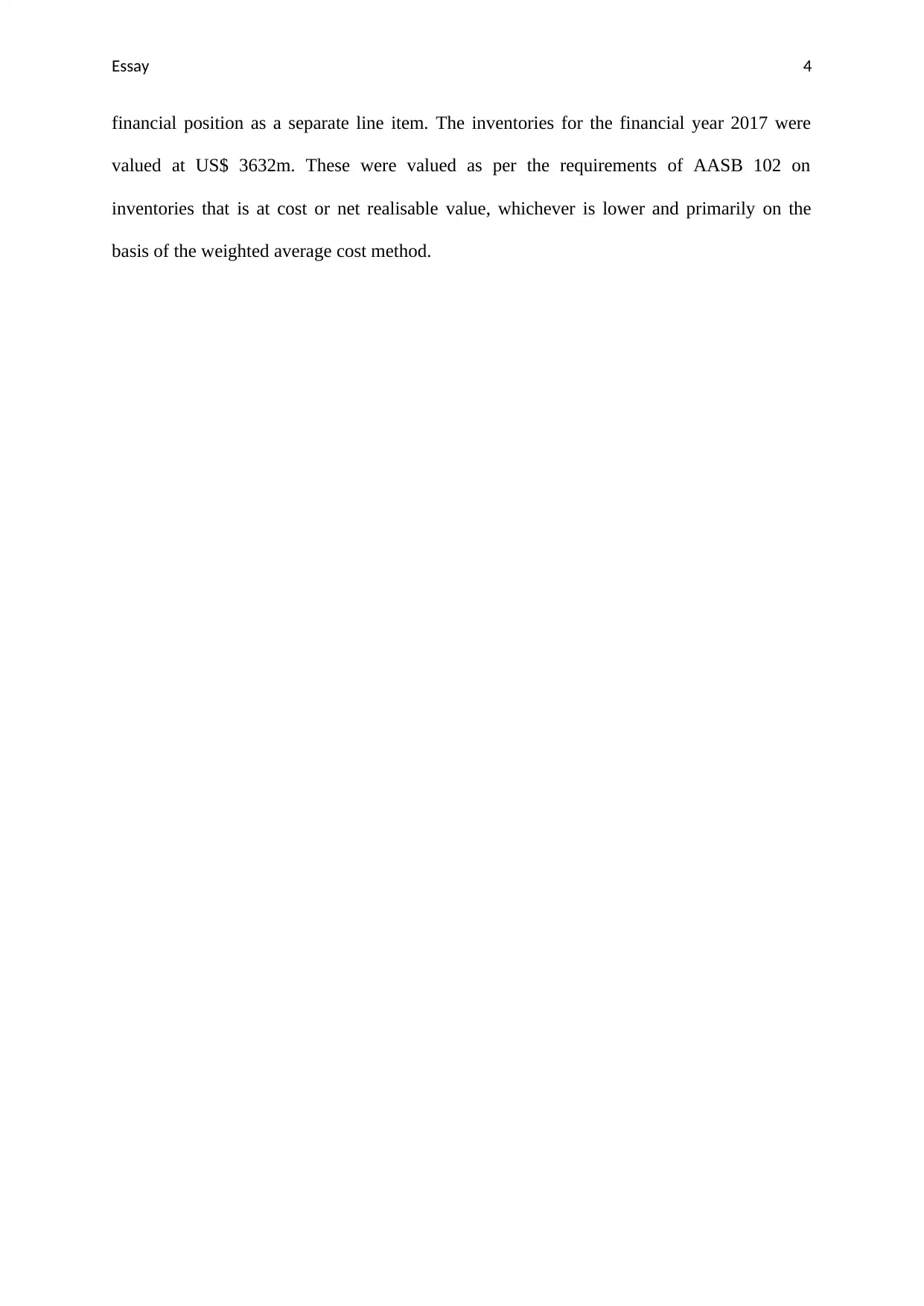
Essay 4
financial position as a separate line item. The inventories for the financial year 2017 were
valued at US$ 3632m. These were valued as per the requirements of AASB 102 on
inventories that is at cost or net realisable value, whichever is lower and primarily on the
basis of the weighted average cost method.
financial position as a separate line item. The inventories for the financial year 2017 were
valued at US$ 3632m. These were valued as per the requirements of AASB 102 on
inventories that is at cost or net realisable value, whichever is lower and primarily on the
basis of the weighted average cost method.

Essay 5
References
AASB. (2015a) Presentation of financial statements. [online] Available from:
http://www.aasb.gov.au/admin/file/content105/c9/AASB101_07-15.pdf [Accessed 28/05/18].
AASB. (2015b) Inventories. [online] Available from:
http://www.aasb.gov.au/admin/file/content105/c9/AASB102_07-15.pdf [Accessed 28/05/18].
Horngren, C., Harrison, W., Oliver, S., Best, P., Fraser, D., and Tan, R. (2012) Financial
accounting. Australia: Pearson Higher Education, pp. 289.
Kinney, M. R., and Raiborn, C. A. (2011) Cost Accounting: Foundations and Evolutions. 8th
ed. Cengage Learning, pp. 216.
Loughran, M. (2011) Financial Accounting For Dummies. New Jersey: Wiley Publishing Inc.
Rich, J., and Jones, J. (2018) Cornerstones of Financial Accounting. 4th ed. Cengage
Learning, pp. 312.
Rio Tinto. (2018) Annual report 2017. [online] Available from:
https://www.riotinto.com/investors/annual-report-16577.aspx [Accessed 28/05/18].
Robinson, T. R., Henry, E., Pirie, W. L., and Broihahn, M. A. (2015) International Financial
Statement Analysis. 3rd ed. New Jersey: John Wiley & Sons Inc., pp. 373-375.
Waller, M. A., and Esper, T. L. (2014) The Definitive Guide to Inventory Management:
Principles and Strategies for the Efficient Flow of Inventory across the Supply Chain. New
Jersey: Pearson Education Inc., pp. 150.
Warren, C. S., Reeve, J. M., and Duchac, J. (2017) Accounting, Chapters 1-13. 27th ed.
Cengage Learning, pp. 353.
References
AASB. (2015a) Presentation of financial statements. [online] Available from:
http://www.aasb.gov.au/admin/file/content105/c9/AASB101_07-15.pdf [Accessed 28/05/18].
AASB. (2015b) Inventories. [online] Available from:
http://www.aasb.gov.au/admin/file/content105/c9/AASB102_07-15.pdf [Accessed 28/05/18].
Horngren, C., Harrison, W., Oliver, S., Best, P., Fraser, D., and Tan, R. (2012) Financial
accounting. Australia: Pearson Higher Education, pp. 289.
Kinney, M. R., and Raiborn, C. A. (2011) Cost Accounting: Foundations and Evolutions. 8th
ed. Cengage Learning, pp. 216.
Loughran, M. (2011) Financial Accounting For Dummies. New Jersey: Wiley Publishing Inc.
Rich, J., and Jones, J. (2018) Cornerstones of Financial Accounting. 4th ed. Cengage
Learning, pp. 312.
Rio Tinto. (2018) Annual report 2017. [online] Available from:
https://www.riotinto.com/investors/annual-report-16577.aspx [Accessed 28/05/18].
Robinson, T. R., Henry, E., Pirie, W. L., and Broihahn, M. A. (2015) International Financial
Statement Analysis. 3rd ed. New Jersey: John Wiley & Sons Inc., pp. 373-375.
Waller, M. A., and Esper, T. L. (2014) The Definitive Guide to Inventory Management:
Principles and Strategies for the Efficient Flow of Inventory across the Supply Chain. New
Jersey: Pearson Education Inc., pp. 150.
Warren, C. S., Reeve, J. M., and Duchac, J. (2017) Accounting, Chapters 1-13. 27th ed.
Cengage Learning, pp. 353.
⊘ This is a preview!⊘
Do you want full access?
Subscribe today to unlock all pages.

Trusted by 1+ million students worldwide
1 out of 6
Related Documents
Your All-in-One AI-Powered Toolkit for Academic Success.
+13062052269
info@desklib.com
Available 24*7 on WhatsApp / Email
![[object Object]](/_next/static/media/star-bottom.7253800d.svg)
Unlock your academic potential
Copyright © 2020–2026 A2Z Services. All Rights Reserved. Developed and managed by ZUCOL.





